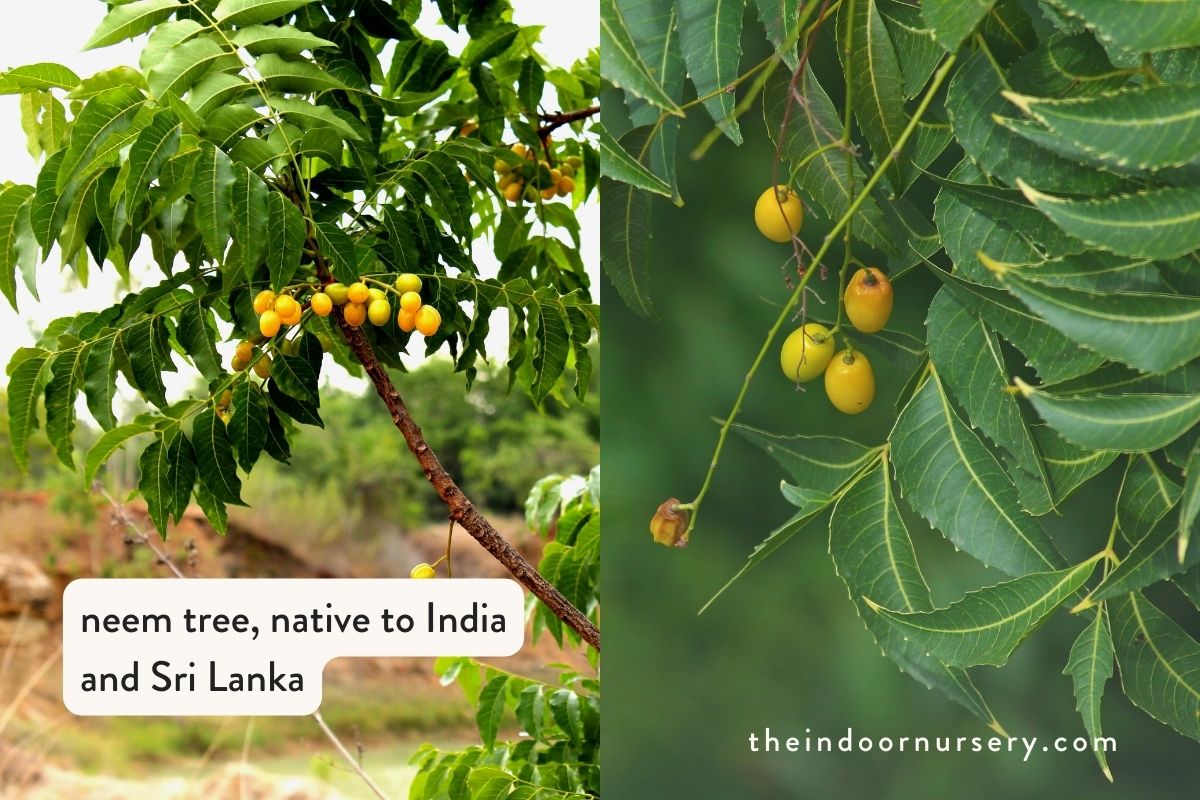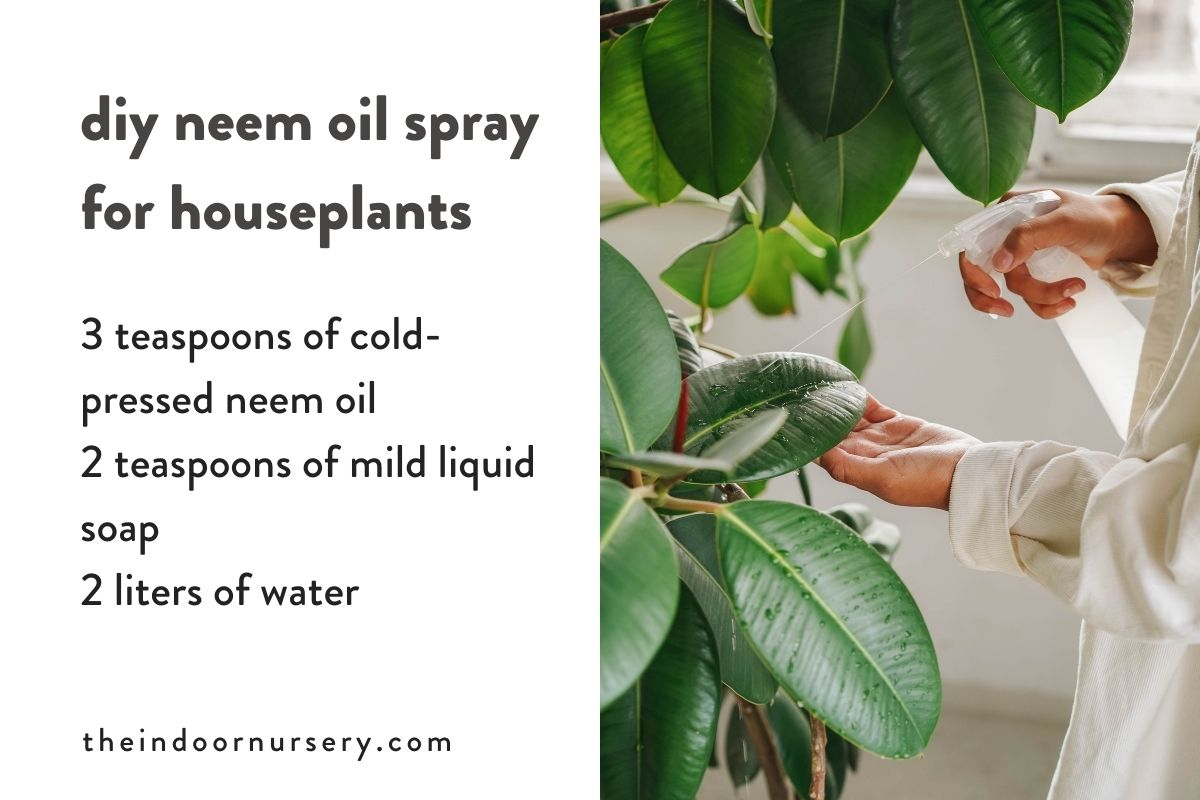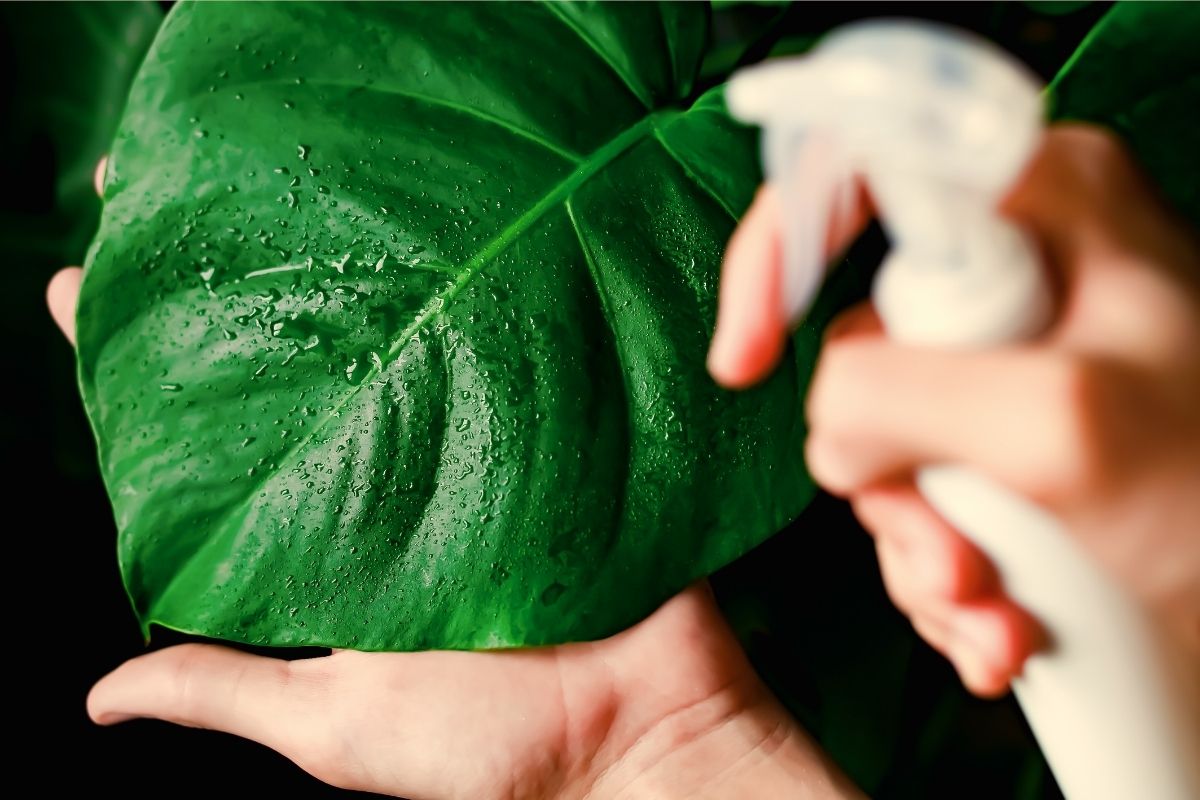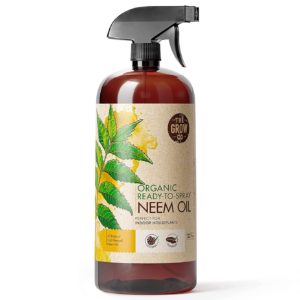Key takeaways:
- Neem oil is a natural pesticide made from the seeds of the neem tree.
- Neem oil contains the active ingredient Azadirachtin, which disrupts the reproductive cycles of pests.
- Neem oil also smothers bugs on contact and prevents eggs from hatching.
- Neem oil can be used to prevent fungal diseases in plants and protect plants from insects.
- Pure neem oil concentrate needs to be diluted before use, while ready-to-use spray is more convenient.
Where there are plants, there are pests. And where there are pests, neem oil can save the day!
Most people work hard to keep their home free of all kinds of creepy-crawly creatures. The reality is that small bugs can still find their way into your home through open windows, cracks in doors, and produce from the grocery store, and even (and especially!!) in the soil of your houseplants.
Wherever your pests come from, their first stop is often that delicious-looking green leaf on your favorite houseplant.
Argh!!! How do you tackle pests without using harsh chemicals in your home? And more importantly; how do you keep them away for good?
This is what you’ll learn in this post:
- What is neem oil?
- How does Neem oil work?
- Choosing the right neem oil for your indoor plant
- How to make a neem oil spray for plants
- How often should you use neem oil on plants?
- When should you use neem oil for plants?
In this article, learn how to use neem oil on houseplants to keep pests away naturally!
What is neem oil?
Neem oil is a naturally occurring oil made from the seed kernels of the neem tree. Neem trees are native to India and Sri Lanka, and the oil from its seeds have long been used to treat skin conditions such as eczema, psoriasis, and dandruff. It turns out that this medicinal oil is an incredible, all-natural pesticide as well.

Soo…how does it work? The active ingredient in neem oil is called Azadirachtin, which is an organic chemical that mimics the natural hormones produced by bugs. When bugs nibble on leaves coated with Azadirachtin, the chemical compound disrupts the hormones regulating the bug’s reproductive cycles. Neem oil also prevents eggs laid by the bug from hatching.
The non-active compounds in neem oil smother bugs on contact. These ingredients immediately attack large, active pest populations, while Azadirachtin works by preventing pest infestations from growing over time.
Because of this, neem oil has become a popular choice for indoor gardeners in recent years. This oil has been used for hundreds of years in traditional Asian medicine, and it’s enjoying a renaissance for its highly effective use as a natural pesticide.
How does Neem oil work?
Neem oil was initially used to treat fungal diseases like powdery mildew in crops and wild plants. While neem oil doesn’t cure an infected plant, it effectively prevents the fungal disease from spreading and damaging other parts of the plant. Outside of preventing the onset and spread of fungal infections, neem oil has historically been used to protect wild plants from both above-ground and below-ground insects by disrupting their ability to reproduce.
Today, neem oil is widely used on houseplants as well as outdoor plants. Gardeners all over the world use this natural pesticide to protect their plants and keep pests away from both their indoor and outdoor gardens.
Choosing the right neem oil for your indoor plant
Neem oil comes in two popular products:
- Ready-to-use sprays
- Pure neem oil concentrate
Pure neem oil needs to be diluted and mixed before use. Each type of neem product has a different active ingredient and works as a pesticide in different ways. To choose the right product for you, knowing how the active ingredients work is important. Here are the key differences between the two types of neem treatments:
While some people turn to chemical pesticides, it’s important to remember that you’re spraying this in your home. As a rule of thumb when choosing pesticides, you should be ok breathing in whatever you spray on your plants. We always recommend that the pesticide you choose is natural and safe for homes – and kids or pets let loose in your home wouldn’t suffer if nibbling a stray leaf. Chemicals in traditional pesticides damage the lungs and are often highly toxic to both humans and pets.
Ready-to-use spray
Ready-to-use neem oil spray usually contains only clarified hydrophobic neem oil. This type of spray will smother an insect on contact by getting into its spiracles, which is the mechanism through which the insect breathes. Because of this, ready-to-use spray is most effective for active infestations. The spray will act quickly and effectively, and many people have success combating infestations with this method. You’ll notice that ready-to-use neem sprays contain very few ingredients from neem – often less than 5% by volume. These products often contain similar ingredients as chemical pesticides, so keep this in mind before stocking up.
Pure neem oil concentrate
Pure neem oil concentrate is more effective for long-term pest control, and is the most popular option for organic gardeners. This concentrate works through the active ingredient Azadirachtin; the compound that interrupts insects’ reproductive cycle. Always read the label of your concentrate thoroughly before applying it, and never apply it directly to your plant! You almost ALWAYS need to dilute neem concentrate with water and add a bit of soap before using it. Read more about how to mix neem oil to learn why.

How to make a neem oil spray for plants (neem oil to water ratio)
Save a few dollars and make your own neem oil spray—it’s easy!
What you’ll need:
- 3 teaspoons of cold-pressed neem oil
- 2 teaspoons of mild liquid soap
- Spray bottle
- 2 liters of water
To transform these ingredients into your own pest-resistant spray, follow these steps:
- Mix all of the ingredients in a large water jug.
- Pour some of the liquid into the spray bottle, making sure the mixture is well combined.
- Put the extra liquid in the fridge to store to be used later.
- Say ciao to your pests!
To treat your plant, spray the top and bottom of your plant’s leaves, coat the stem thoroughly, spritz the potting soil, and you’re done!
How often should you use neem oil on plants?
How often to spray neem oil
Spray your neem solution on indoor and outdoor plants every 1-2 weeks. Apply once a month as a preventative measure against pests.
If you notice that your houseplant leaves have little holes in them or webbing around where the leaves meet the stem, this is a warning sign that pests are present! It’s handy to have some ready-to-use spray available to treat problems like this as they arise.
How to apply neem oil to plants
When you apply neem oil, make sure to coat the top and bottom of your plant leaves completely. Many people forget to spray the bottom of the leaves, but don’t skip this step! Bugs often hang on the underside of leaves and lay their eggs here as well. To ensure you’re protecting your plants completely, we also recommend lightly spraying the stems and soil for full coverage.
More neem oil isn’t necessarily better though. If you spray your plant too often, a thick layer of neem oil can suffocate the leaves and disrupt photosynthesis. When this happens, you will notice your plant leaves start to droop and turn yellow.
When to avoid using neem oil
Neem oil should only be used on healthy plants, as it can worsen common plant health issues. Do not use neem oil 🚫 on plants in the following conditions or with the following preferences:
- Plants that prefer dry conditions. This includes plants such as succulents, cactuses, and calathea, among others. These types of plants prefer dryness and low humidity, so introducing excess moisture in the form of neem spray can damage their tissues.
- Plants with yellowing leaves. There are many causes behind yellowing leaves, but they all indicate that a plant is struggling. In this case, neem oil can exacerbate the condition and further worsen the plant’s health. This is because the neem oil can further block the pores of the plant’s leaves and make it difficult for it to get the nutrients it needs.
- Plants in direct sunlight. We recommend applying neem oil in the evening and ensuring that the treated plant will be out of direct sunlight for a few days. Due to its refractive properties (the same tanning oil possesses), neem oil can make the leaves more sensitive to sunlight and cause leaf burn. We recommend moving the plant to a darker room for a few days after application and then returning it to its normal location once the oil has been absorbed.
When should you use neem oil for plants?
Neem oil is useful for both the prevention and treatment of pest infestations in plants. Knowing how to use neem oil properly will ensure you are making the most of its wide range of benefits. Neem oil is effective on most plants; however, it should not be used on stressed plants – this means transplants, folks! It will also work most effectively for plants with smooth leaves and stems with moderate to heavy watering needs (the water flushes the neem through the soil and prevents the compounds from burning plant tissues).
Here are a few of our go-to neem oil hacks:
Pest control
Neem oil is useful for killing a number of insects, including aphids, whiteflies, gnats, mealybugs, spider mites, nematodes, thrips, and fungus gnats. For the most effective pest control, use a clarified, hydrophobic neem oil spray that actively targets live bugs.
Preventive measure
Neem oil can also be used as a preventative measure by applying once every week or two. This is done by targeting the reproductive cycle of the bugs over time and essentially stopping the problem before it begins. When applying to plants, treat them in the evenings and move the plants out of direct sunlight for the first few days to prevent damage.
Leaf shine
Outside of pest control, neem oil can be used as a leaf shine for plants. This is especially important for indoor plants because dust accumulates on leaves over time, interfering with photosynthesis and resulting in tired-looking, energy deficient foliage. When used as a leaf shine, neem oil is best suited for indoor plants with large leaves. Dilute the oil as instructed, coat the leaf with your spray, and then wipe with a damp cloth. This treatment both cleans the leaf of dust and leaves behind a thin coat of neem oil to keep bugs away.
Soil drench
While neem oil is commonly used for above-ground pests, underground pest infestations can also be treated with neem oil. This is done through a soil drench. To make a soil drench, dilute your neem oil concentrate as instructed and pour it directly over the base of your plant. Repeat 2-3 times a month, for up to 6 treatments.
The bottom line
Don’t let pesky bugs wreak havoc on your houseplants! People cultivate indoor gardens to bring serenity into their homes, improve mental health, and grow herbs, veggies and beautiful flowers for all to enjoy. You don’t need to use heavy chemical pesticides to keep your indoor garden lush though – with neem oil, a bit of patience, and consistent care, you can keep your plants healthy without bringing toxins into your home.
Neem oil is renowned for its naturally occurring pesticide properties and its ability to act as both an active and preventative measure against unwanted bugs of all kinds. By using a DIY neem spray, you can help your plants thrive and feel confident that you’re making a healthy choice for your home. Bugs beware!! 🦟 🚫
More About Pest Control
- How To Get Rid Of Scale On Plants
- The Best Neem Oil For Plants: Our Top Picks
- How to make homemade spray to keep cats from eating plants
- 12 essential oils for plants that treat pests, fungus, and more
- How to mix neem oil for plants with 3 simple ingredients
- What plants NOT to use neem oil on
- Most common cannabis pests and how to treat them
- Tags:
- neem oil
- pest control
- Pests





